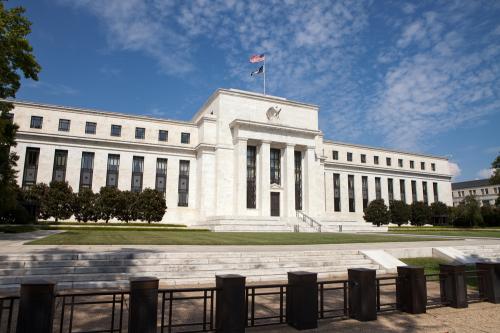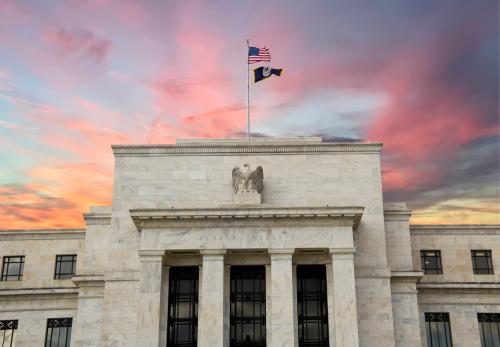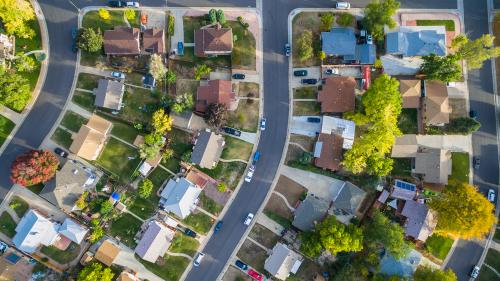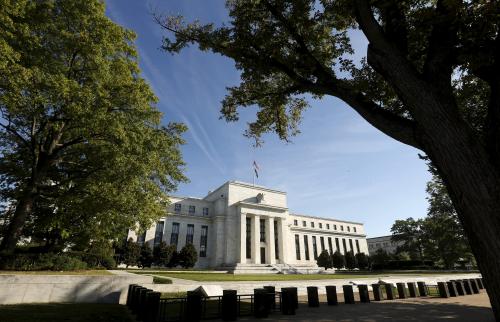With the Federal Reserve’s key inflation measure—the Personal Consumption Expenditures (PCE) price index excluding food and energy—averaging 1.9% over the past six months, it might seem as if the soft landing has been achieved. So why isn’t the Fed declaring victory?
In this post, I argue that the details of the inflation data suggest that the post-pandemic adjustment in inflation is still underway, meaning that there is still much uncertainty about the trajectory of inflation. That doesn’t mean that inflation will necessarily increase in 2024—just that there are reasonable scenarios under which it could. There are also reasonable scenarios in which inflation in 2024 hits or even undershoots the Fed’s 2% target.
This table summarizes the recent data on PCE inflation for various components of spending over various horizons ending in November 2023. Readings over the past six months for core inflation (excluding volatile energy and food prices) suggest that inflation is roughly at the Fed’s 2% target. But the components show that inflation is being held down by deflation in goods prices, particularly in recent months, and boosted by rapid inflation in housing services.
To get a better sense of whether we are “back to normal,” this next table compares inflation for the various components of consumption to its average pace from 2015 to 2019 (calculated as the change from December 2014 to December 2019). The table tells pretty much the same story—relative to the 2015 to 2019 trend, goods prices have been rising much less, housing services have been rising much more, and PCE services excluding housing and energy have been rising a bit faster. Goods prices are falling faster than the 2015-2019 average; services prices are rising faster.
One way of understanding these recent data is to look at the level of relative prices. For example, during the pandemic, goods prices rose much faster than usual, and so the relative price of goods compared to the average core PCE price rose.
While there is no guarantee that relative prices will be fully restored, some normalization seems likely—and as shown in the figure above, is already underway. It is this normalization that accounts for the declines in goods prices we have seen over the past year. However, the relative price of goods prices is still above where we would have expected it to be pre-pandemic—shown by the dotted line—suggesting that there is still scope for goods prices to continue falling for some time.
The following chart explores relative prices for a more detailed breakdown of consumptions items. In particular, it shows the percentage difference between the actual relative price (the ratio of the price of each component compared to the core PCE price) compared to what would have been expected based on pre-pandemic trends.
The relative price of motor vehicles and furniture and other durable household items is quite high. These are items for which demand soared during the pandemic, while the ability of the market to meet that demand was constrained by supply chain problems. It seems likely that prices for these goods will continue falling for some time.
It may seem surprising that the relative price of housing is a bit lower than would have been expected based on pre-pandemic trends. That is, in part, because pre-pandemic trends also showed rapid increases in housing costs (averaging 3.2% per year from 2015-2020, compared to just 1.7% for core PCE). It is also because of lags in the adjustment of housing service costs to market rents—reflecting the fact that rents for continuing tenants take time to adjust to market rents, and the fact that the BLS spreads rent increases slowly over time. (See this explainer for more details on housing service prices.)
Zillow’s observed rent index—a better measure of current market rents—shows that rents have increased about 9% more since the start of the pandemic than the price of housing services as measured in the national accounts. Thus, the relative price of market rents is above what would have been expected based on pre-pandemic trends. Whether the relative price of housing services will return to its pre-pandemic trend is unclear. The pandemic and the shift to hybrid/remote work seem to have permanently boosted the demand for housing, and so it is possible that the relative price of housing will remain permanently higher. On the other hand, there is a lot of supply of multi-family housing coming to the market in 2024, and market rents may soften as a result.
PCE rents are catching up to Zillow rents—PCE rent inflation (at an annual rate) has been on average 3.7 percentage points higher than Zillow rent inflation since June of 2022.
Thus the rent story is a complicated one: PCE rents have to increase 7% more to catch up with current market rents, but market rents may start falling, in which case the actual PCE adjustment could be less. But it seems likely that inflation of housing services will remain high for at least the next 6 months, if not more.
Returning to the chart above, we see that prices for financial services and insurance and for health care are well below what would have been expected based on pre-pandemic trends. I don’t have much to say about prices for financial services—these tend to be noisy, and a large component is imputed.
The health care story, however, is more interesting. (Actually, about 20% of financial services and insurance spending reflects health costs through the health insurance component.) The very low levels of health service inflation over the past few years reflect extremely low price increases for services of Medicare beneficiaries, which have increased at an annual rate of just 2% since the start of the pandemic. These low prices reflect legislated payment updates which have been about 3% for most non-physician services, and negative for physician services. Some of the extremely low levels of inflation seen over the past year reflect the unwinding of temporary payment increases during the pandemic, but looking forward, Medicare price inflation seems likely to remain in the 2% range or lower. (For a more detailed discussion of health inflation by payer, see Fiedler, 2022).
What does this all mean for inflation going forward?
I see several countervailing forces: rent inflation seems likely to continue running high for a year or two, and goods prices seem likely to continue running low. Both of these factors will be “transitory” and part of the unwinding of the pandemic inflation episode. In addition, there is uncertainty about inflation in non-housing services: it is possible that the recent slowdown in wage growth will mean a slowdown in inflation, but much depends on the strength of the underlying economy as well.
In short, it is hard to know what inflation will look like over the next year. Furthermore, it seems like it may be a number of years before the full pandemic inflation cycle is completed.
-
Acknowledgements and disclosures
The Brookings Institution is financed through the support of a diverse array of foundations, corporations, governments, individuals, as well as an endowment. A list of donors can be found in our annual reports published online here. The findings, interpretations, and conclusions in this report are solely those of its author(s) and are not influenced by any donation.
The Brookings Institution is committed to quality, independence, and impact.
We are supported by a diverse array of funders. In line with our values and policies, each Brookings publication represents the sole views of its author(s).








Commentary
Op-edThe pandemic inflation episode is still unwinding
January 12, 2024